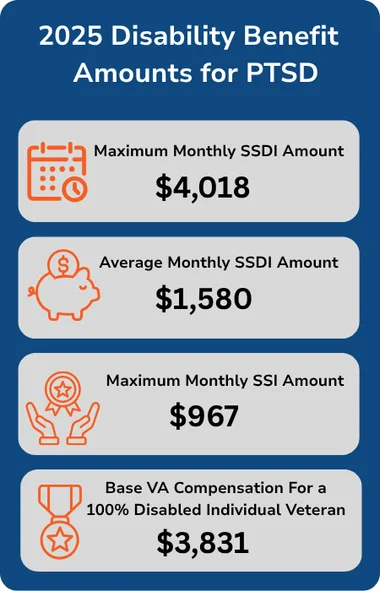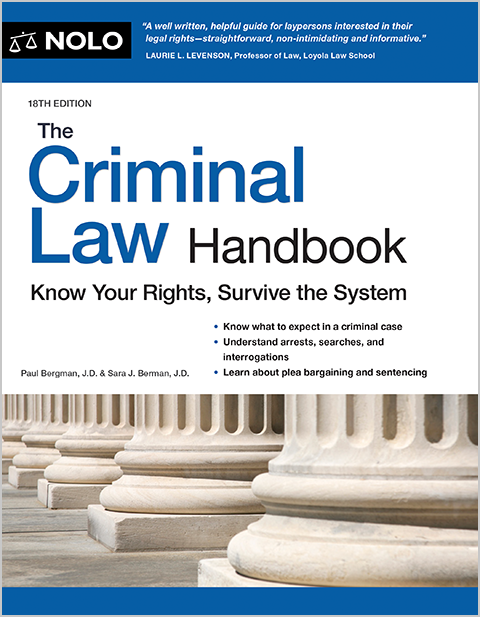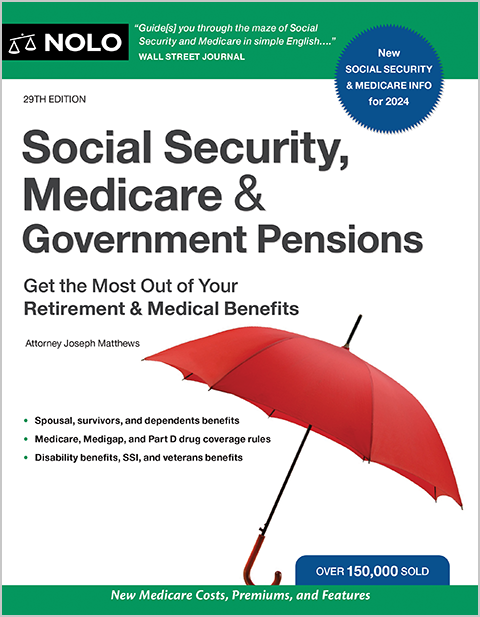Proper medical documentation is the basis of a successful Social Security disability claim for post-traumatic stress disorder (PTSD).
Post-traumatic stress disorder (PTSD) is an anxiety disorder that can develop after exposure to a shocking or frightening event, such as military combat, sexual assault, childhood abuse, a serious accident, or a natural disaster. People with PTSD may experience nightmares, flashbacks, or panic attacks that seriously interfere with everyday life activities.
Some people with PTSD can successfully manage the disorder with counseling, therapy, and anti-anxiety medications. But others with very intense symptoms can find it difficult to engage in regular employment even in the least stressful environments. If you're struggling to hold down a job due to symptoms from PTSD, you should be aware of the Social Security disability benefits that may be available to you.
Is PTSD a Disability?
It can be, if your PTSD symptoms keep you from working full-time for 12 months or longer. Social Security needs to see that you have a medical condition that keeps you from engaging in substantial gainful activity for at least one year. You can do this in one of two ways—by satisfying the requirements of the Blue Book listing for trauma-related disorders, or under a medical-vocational allowance because your PTSD symptoms rule out all jobs. Either way, you must show that your PTSD significantly limits your ability to complete your daily routine.
Potentially Disabling PTSD Symptoms
PTSD symptoms can be as specific to each person as the trauma-causing event ("stressor"). Some people will think obsessively about their stressor, while others will become emotionally numb and avoid thinking about it at all costs. However, there are some symptoms that are common to many people diagnosed with PTSD, such as:
- feelings of hopelessness, guilt, or shame
- difficulty concentrating or remembering things
- anger and irritability
- trouble sleeping, and
- excessive anxiety or fear.
While almost everybody who has lived through a traumatic event will feel some degree of shock or fear as a result, people with PTSD have long-lasting, intense symptoms that, when left untreated, tend to get worse over time. Treatment for PTSD often includes some combination of medication, counseling, cognitive-behavioral therapy, or psychotherapy.
Getting Disability by Meeting the PTSD Listing
One method of getting benefits for PTSD is called "meeting a listing." Disability listings are disorders that Social Security considers especially serious. Each numbered listing has a set of requirements that you need to fulfill in order to "meet the listing" and receive benefits.
The disability listing for PTSD is found under Blue Book section 12.00 for mental impairments. Listing 12.15 concerns trauma- and stressor-related disorders (such as PTSD) specifically. You can meet the listing criteria with medical documentation of all of the following:
- exposure to actual or threatened death, serious injury, or violence
- subsequent involuntary re-experiencing of the traumatic event (for example, intrusive memories, dreams, or flashbacks)
- avoidance of external reminders of the event
- disturbance in mood and behavior, and
- increases in "arousal and reactivity" (for example, exaggerated startle response, sleep disturbance).
In addition to having evidence of all of the above symptoms, you'll need to show that you have "marked" limitations in two, or an "extreme" limitation in one, of the following functional areas:
- adapting or managing oneself (regulating one's emotions, adapting to changes, having practical personal skills like cooking, cleaning, and wearing appropriate attire)
- interacting with others (in socially appropriate ways)
- concentrating on tasks (being able to finish work at a reasonable pace), and
- learning, understanding, and remembering information (including following instructions and applying new knowledge to tasks).
"Extreme" limitations are worse than "marked" limitations—you can think of a marked limitation as being able to function independently in an area (but with significant difficulty), while an extreme limitation means you can't function on your own in that area for any meaningful period of time.
You can also meet listing 12.15 if you don't currently have any extreme or marked limitations because you're living in a highly structured or protected setting (such as a group home) and you have limited capacity to adapt to changes outside of that environment.
Getting Disability for PTSD by a Medical-Vocational Allowance
Even if you don't meet the requirements of listing 12.15, you can still collect benefits through what's called a "medical-vocational allowance." A medical-vocational allowance is based on how much your functional limitations restrict your ability to work, taking into consideration factors such as your age, education, skills, and residual functional capacity (RFC).
Your RFC is a set of limitations, physical and mental, on what you can and can't do at work. Social Security looks at your medical records and function reports to determine how much your symptoms interfere with the types of jobs you can do. For example, somebody with fairly well controlled PTSD may have an RFC prohibiting loud work environments that could trigger flashbacks, while another applicant struggling with constant intrusive thoughts might have an RFC restricting them from performing even simple, repetitive tasks.
Social Security compares your RFC with your past work to see if you could return to those jobs today. If not, the agency then determines whether any other jobs exist that you could do, despite the restrictions in your RFC. People who are unable to perform any other full-time work (or who aren't expected to learn) will receive disability benefits.
How Hard Is It to Get Disability for PTSD?
With proper medical documentation, qualifying for disability based on PTSD doesn't have to be a challenge. The disorder is probably one of the more familiar mental impairments seen by Social Security claims examiners and disability judges, so it's less likely that your symptoms will be misunderstood. However, you'll still need to be on top of your game when it comes to gathering and submitting your medical evidence.
Make sure that Social Security has all the medical records related to your PTSD, including inpatient or outpatient psychiatric treatment records and clinical notes from counseling and therapy. The agency will usually request treatment records from the previous year when you file your disability application, but you should provide Social Security with all relevant records from the last several years, if not more.
You should also ask your regular mental health provider if they'd be willing to complete an RFC form or write a letter that addresses the work-related limitations caused by your PTSD. Social Security generally gives special consideration to the opinions of treating doctors, and an RFC form can make the difference between your disability claim being approved or denied. A helpful RFC form should address your ability to:
- sustain a routine without special supervision
- maintain attention and concentration
- understand, remember, and carry out simple and complex instructions
- avoid excessive absences from work (more than two days per month)
- make simple work-related decisions
- interact appropriately with supervisors, coworkers, and the general public, and
- be on time to work and avoid taking unscheduled breaks from the job.
Your doctor should also state the medical basis for your limitations and discuss whether these limitations meet the requirements of the PTSD listing. Third-party statements written by friends, family, or former bosses can also be helpful in demonstrating that you're not able to work. The statements should focus on the third party's observations of you and their interactions with you, rather than your medical issues.
How Much Disability Will I Get for PTSD?
Social Security doesn't calculate your benefit amounts based on the type of disabling condition you have. Instead, the agency administers two types of benefits for disabled people—Social Security Disability Insurance (SSDI) and Supplemental Security Income (SSI).
Each program has its own legal eligibility criteria that you'll need to meet before you can collect that type of benefit. SSDI eligibility is determined by your work history, while SSI is needs-based and requires that you meet a low income and asset threshold. You can be eligible for both SSDI and SSI, but you won't receive more than the maximum amount you'd get from SSDI alone.
In 2025, if you're approved for SSDI, you can receive up to $4,018 per month, but the average amount is much lower, at $1,580. That's because SSDI amounts are calculated on your past earnings history, which varies significantly between beneficiaries. If you're receiving SSI, you can get $967 per month minus any countable income you have for that month. Many states provide a modest SSI supplemental benefit amount depending on your living situation.
How to Apply for SSDI or SSI Benefits
Applying for benefits is a fairly straightforward process, with many people choosing to use Social Security's electronic application tool. You can also call the agency's national hotline at 800-772-1213 from 8 a.m. to 7 p.m., Monday through Friday, or go in person to your local Social Security field office. When you're ready to begin your application for SSDI or SSI, you may want to check out our article on filing for Social Security disability benefits for more information. And if you're unsure whether you want to go through the application process alone, review our article on when to talk to a Social Security disability lawyer. While you don't need hire an attorney at any part of the process, it can be a good idea—especially if you need to appeal a denial.


